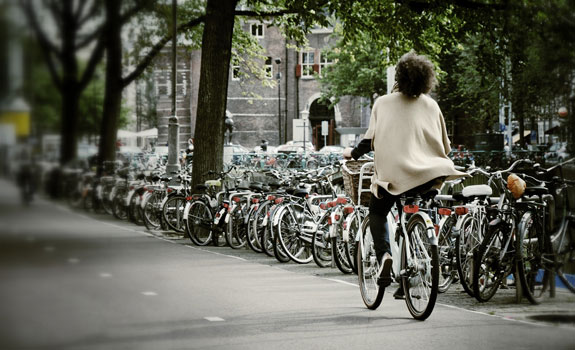Note: GJEL Accident Attorneys regularly sponsors coverage on Streetsblog San Francisco and Streetsblog California. Unless noted in the story, GJEL Accident Attorneys is not consulted for the content or editorial direction of the sponsored content.
If you want sustainable transportation to attract riders, you need to make it inviting. "You can't just dare people to bike," said Bas Govers, Program Director with Excellent Cities. "I think we should have a more holistic approach," he said. "What is the urban environment communicating to its users?"
Govers made his comments as part of a panel discussion hosted by the Netherlands on sustainable mobility in urban areas which is part of the Global Climate Action Summit this week in San Francisco. His implication is that street designs in San Francisco and the rest of the Bay Area, by assigning most road space to automobiles, encourages people to drive. Reversing that is going to take more than just bike lanes: it will mean a radical redesign of our streets.
The Dutch, of course, are arguably (is it even arguably?) the world leaders in getting people out of cars and using sustainable transportation; seventy percent of trips in the Netherlands are done by bicycle or public transit. But this is achievable in the Bay Area and the U.S. generally, said Giovanni Circella, a researcher at UC Davis who was also on the panel. "Davis is the only city in America that has this in common with the Netherlands: we have more bicycles than people," he pointed out. But that didn't just happen--it required the city to adopt and maintain a paving program that puts walking and bicycling "at the core of our policies."
Circella's research focuses on maintaining that commitment, but also on anticipating how policies will have to change to accommodate new mobility choices. "Electric scooters are becoming a big phenomenon, and there is a big opportunity, if we can align incentives for people to live without a car."
Living without a car, however, doesn't mean never using a car, pointed out the panelists. It just means a future where people, when they do need to drive, use ride-hail cars (and, in the future, autonomous cars), sometimes connecting to public transportation. This, explained Circella, is a way to make public transportation more accessible in sprawling areas of the U.S. and to solve the 'last mile problem' connecting people's homes and offices with transit hubs. But, he warned, "We need to be careful not to cannibalize public transportation."
He cited research that indicates that, thus far, ride-hailing isn't supporting public transportation, but is instead pulling people from it. "So we need policies that align with sustainability."
One of those policies would be to raise car and gas taxes to reflect the real costs and damaging effects of automobiles, while reducing or eliminating taxes and fees for people who bike or use scooters and public transportation. "Mobility is at the core of what humans do," said Baerte de Brey, Chief International Officer of ElaadNL, a provider of electric charging infrastructure. "We want to go anywhere and everywhere, and governments tax it. If we reduce taxes on clean mobility, or have no tax at all, in the end everybody will be sustainable."
De Brey sees a future where there might be ten electric cars available at electric charging hubs in a neighborhood, so people don't even need to own cars or have garages--instead they can reserve an electric car when they need one. Electric cars would be integrated with the grid, with their batteries being a source of supplemental energy for homes and factories when solar or wind power is less plentiful. "We call that bi-directional charging, or vehicle to grid," he said. "This will integrate mobility into your energy system." His company has also developed standard chargers that can be used by Tesla, BMW, and other makers of electric cars.
Of course, given induced demand, these innovations are still unlikely to solve congestion. In fact, it might not even fully solve problems from emissions, depending on how the electricity is generated and other factors. "Air pollution causes about seven million premature deaths a year globally," said Guus Velders, professor of air quality and climate interactions at Utrecht University, who was also on the panel. He explained that it's not even fully understood how much of that is directly from tailpipe emissions. "Road wear [and] tire wear also cause particulates," he said, which can damage lungs.

So no matter how efficient cars get, the answer, said the panelists, is still to aggressively pursue policies that just make it easier not to drive. Govers envisions streets that make people happy to bike to work, because traffic is calmed, or they have incredibly safe bike infrastructure, and are also inviting for walking. "In San Francisco, twenty percent of car trips are under three miles, so the potential is there for cycling," he said. He envisions attractive, inviting hubs that have bike-share, e-scooters, and transit available, and perhaps even car-share. "We have to take the consumer perspective" towards transportation, he said. "The consumer wants to be safe, he wants transportation to be reliable, but he also wants to be surprised… he wants to say 'I like it.' I like electric driving. I like cycling. It’s bringing me something and I’m enjoying it. Let commuting be something you’re going to like."
The Global Climate Action Summit, of which this panel was a part, continues through Friday.





